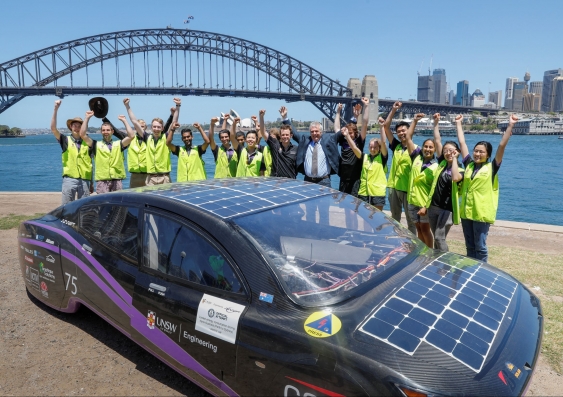The University of New South Wales (UNSW) solar racing team, also known as Sunswift, has added another achievement to their impressive list by setting a new efficiency world record for an electric car.
To set the record, the team had to keep the car’s energy consumption to under 5.5kWh/100km. Actual energy consumption throughout the journey was an average of 3.25kWh/100km, which is about 17 times less than an average Australian car, the UNSW reported.
The student team managed to complete the 4,100km journey between Perth and Sydney, traveling an average of 600km a day, in the car named Violet.
Violet, which is the sixth-generation solar car built by Sunswift, a 22-year-old, student-led initiative at UNSW, used about the same energy per day as that of a standard household (20-24kWh).
This means that the cost to run the car from Perth to Sydney’s McMahon’s Point was also economical, at well under $50.
“These students have pushed the boundaries of modern engineering and proven that solar powered cars are likely to be a big part of Australia’s motoring future,” sad UNSW Dean of Engineering Professor Mark Hoffman, who greeted the team at the finish line.
“They worked extremely hard to prepare for this journey and despite setbacks, they’ve shown resilience, bounced back like professionals and got on with the job. This is what a university degree should entail – actual, hands-on experience and overcoming real-world challenges.”
Indeed, the team of 14 students experienced a number of setbacks over the past year, including a rear suspension failure during the 2017 Bridgestone World Solar Challenge and a battery fire in October, but managed to complete the journey across Australia in just six days and two days ahead of schedule.
In comparison to previous generations of Sunswift vehicles, Violet is the first four-seat, four-door vehicle. It is designed as a family vehicle with an eye on the team’s goal to build a car that can meet the requirements for road registration in Australia.
It features a five-square-metre solar array consisting of 318 SunPower monocrystalline silicon cells with an approximate efficiency of 22% and a modular 10-20 kWh lithium ion battery. It has a maximum speed of 140 km/h.
However, it seems that steering Violet on the road is not an easy task.
“Violet is lively on the road a lot, it’s not a production car and you have to kind of handle it like a horse in order to manage it on public roads. But we did it,” said Hayden Smith, a 25-year-old computer science honours student.
This is not the first time for the UNSW Sunswift solar car team to enter the Guinness Book of Records. Back in 2011, the team smashed a record for the world’s fastest solar vehicle after reaching speeds of more than 88 km/h with its Sunswift IVy model.
The next time Violet will hit the road in a major competition will be at the upcoming Bridgestone World Solar Challenge in 2019, held traditionally in October.
This content is protected by copyright and may not be reused. If you want to cooperate with us and would like to reuse some of our content, please contact: editors@pv-magazine.com.









By submitting this form you agree to pv magazine using your data for the purposes of publishing your comment.
Your personal data will only be disclosed or otherwise transmitted to third parties for the purposes of spam filtering or if this is necessary for technical maintenance of the website. Any other transfer to third parties will not take place unless this is justified on the basis of applicable data protection regulations or if pv magazine is legally obliged to do so.
You may revoke this consent at any time with effect for the future, in which case your personal data will be deleted immediately. Otherwise, your data will be deleted if pv magazine has processed your request or the purpose of data storage is fulfilled.
Further information on data privacy can be found in our Data Protection Policy.